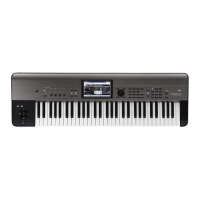PROG P3: Filter 3–5: Filter1 EG
31
LFO modulation of Filter Cutoff
Intensity to B [–99...+99]
This controls the initial effect of the LFO on Filter B’s cutoff
frequency, before any JS‐Y or AMS modulation.
JS–Y Intensity to A [–99...+99]
This adjusts the depth by which the LFO will modulate the
cutoff frequency of filter A when you move the joystick from
the center in the –Y direction (toward yourself) (or when
CC#2 is received). (Joystick control in the –Y direction is
called “JS –Y”.)
Negative (–) settings will invert the phase of the LFO. You
can also use this to reduce the initial amount of the LFO, as
set by Intensity to A, above. For example:
1. Set Intensity to A to +50.
The LFO will now have a fairly strong effect on the filter
cutoff.
2. Set JS-Y Intensity to A to –50.
Now, if you move the joystick down, the effect of the LFO
will fade away. When the joystick is all the way at the
bottom of its range, the LFO will be completely cancelled
out.
JS–Y Intensity to B (LFO1) [–99...+99]
This lets you use JS‐Y to scale the amount of the LFO applied
to Filter B.
AMS (LFO1) [List of AMS Sources]
This selects any AMS modulation source to scale the amount
of the LFO applied to Filters A and B. The two filters share a
single AMS source, but with separate intensity settings.
For a list of AMS sources, please see “AMS (Alternate
Modulation Source) List” on page 340.
Intensity to A (LFO1) [–99...+99]
This controls the depth and direction of the LFO1 AMS
modulation for Filter A.
For example, if AMS is set to JS+Y: CC#01, positive settings
mean that YS+Y will increase the amount of LFO1 applied to
Filter A.
Intensity to B (LFO1) [–99...+99]
This controls the depth and direction of the LFO1 AMS
modulation for Filter B.
LFO 2
The parameters for LFO2 are identical to those for LFO1. For
more information, please see the descriptions under LFO1,
above.
3–4b: Common LFO
The parameters for the Common LFO are identical to those
for LFO1. For more information, please see the descriptions
under LFO1, above.
Note that while LFO1 and LFO2 are separate for each voice,
the Common LFO is shared by all voices in the Program.
This makes it useful when you want all of the voices to have
an identical LFO effect.
V
3–4: Menu Command
•0: Write Program see p. 64
•1: Exclusive Solo see p. 64
•2: Auto Song Setup see p. 65
•3: Copy Oscillator see p. 65
•4: Swap Oscillator see p. 65
For more information, please see “Program: Menu
Command” on page 64.
3–5: Filter1 EG
The Filter EG, or Envelope Generator, lets you create
complex, time‐varying changes to the cutoff frequencies of
Filters A and B. The parameters on this page control the
shape of the EG. Among other things, you can:
• Create the basic EG shape by setting the levels and times
of each segment.
• Control the curvature of each EG segment, for subtle
control over the modulation shape of the EG.
• Set up complex modulation of EG levels and times.
• Set up an AMS source, such as an LFO, to restart the EG.
To control how much effect the EG has on the filters, use the
Filter EG parameters on the P3: Filter– Modulation page, as
described under “3–3a: Filter EG” on page 29.
Filter EG is also an AMS source
You can use the Filter EG as an AMS source to modulate
other parameters, just like the keyboard tracking and LFOs.
Simply select the Filter EG in the AMS list for the desired
parameter.
3–5a: EG Reset
AMS [List of AMS Sources]
This selects an AMS source to reset the EG to the start point.
For instance, you can use a tempo‐synced LFO to trigger the
EG in a repeating rhythm. This reset is in addition to the
initial note‐on, which always causes the EG to start.
For a list of AMS sources, please see “AMS (Alternate
Modulation Source) List” on page 340.
Threshold [–99...+99]
This sets the AMS level which will trigger the EG reset.
Among other things, you can use this to adjust the exact
point in an LFO’s phase at which the EG will be reset,
effectively controlling its “groove” against other rhythmic
effects.
When the threshold is positive, the EG triggers when
passing through the threshold moving upwards. When the
threshold is negative, the EG triggers when passing through
the threshold moving downwards.
Note: With some LFO shapes, and with faster LFO speeds,
the LFO may not always reach the extreme values of +99 or –

